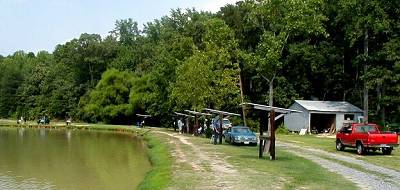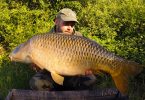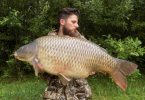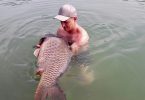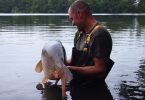I had a chance yesterday to visit a NC Carp Paylake and watch Gary Shears and son Josh compete. Interesting trip. Interesting lake. Since none of the UK/SA/Euro folks have ever seen a Carp Paylake and many US folks haven’t either, thought I’d give a report of yesterday’s activities and some detail. Gary estimates there are around 75-100 paylakes in NC and says this one is fairly typical.
We met at XXX (well, I can’t tell EVERYTHING) near Statesville, NC. I got there around 3:30 and Gary around 4:30. Drive was a bit over an hour for each of us but from different directions. Gary & Josh were fishing the evening session which starts at 5pm and runs until 1am. The 2 lakes hold (I think) 75 pegs and most were occupied. At 3 rods per angler, this made for a lot of bait in the water. The pegs each have a small covered bench for holding buckets of bait and such.

The two lakes are small (largest is maybe 1/4 mile long and 50 yds wide) with pegs along each side. The center is marked with a floating cable which serves to divide it (you can only fish from shore to the center) and to provide power to the sprinklers that run all the time to help oxygenate the lakes. The lakes are completely featureless with the bottom from 8 to 10 ft and flat except for one hump where an original dam was before the lake was expanded. This should make the pegs all pretty much the same and have the catching down to a matter of bait and rig. Turns out that this isn’t the case as the newest section of the lake (around a year old now) produces very few fish but they are usually lumps. The evening I was there, one small area was out-producing the rest of the lake by a noticeable margin. Go figure. Gary fishes this lake regularly and says this isn’t unusual although the “hot spot” moves around and is sometimes absent with fish taken pretty evenly throughout the older section (3/4 of it) of the lake. I was standing near the store/older section shooting towards the new part in this picture.

These lakes are stocked with huge numbers of carp from 10 to well over 30lbs. Almost no other fish in the water and nothing but carp are ever fished for. This particular lake regularly produces high 20s and the occasional 30 . Interestingly enough, the lake was restocked this past spring with fish from 10lbs to several mid 30s. None of these new 30s have been on the bank even once. There must be good profit in running one of these as the last stocking was around 12,000 lbs of carp at around 65¢ per lb (£0.45).
Paylakes operate by each angler paying in a certain amount of money and then money is paid out hourly for the 3 largest fish, at the end of the session for largest fish, and numerous other “pools” for the day such as catching a fish closest to a certain weight (which changes with each match). This lake operates two sessions per day on Wed, Fri, Sat, Sun. The hourly payout this time was $120 each hour for the 3 largest fish at $60, $40, $20. I had to leave before the finish and didn’t find out what the session payout was to be – maybe Gary will let me know about that and the pools when he reads this.
I’ve read many times about the variety of flavors available to the UK carpers and was a bit envious. Thus, I was shocked when I went to the store on the grounds operated by the lake owner. In the section of the store given over to baits and flavors (about half the place I think) I way more different bottles of flavoring than I’d ever imagined. Everything from chocolates to clear corn to at least a dozen different berry ones. Awesome. Huge bottles too.

Gary, Josh, and a friend arrived in Gary’s CarpVan which has hangers for rods and lots of shelves for bait mixes and additives. They quickly began to set up and you could tell this was a very practiced maneuver. Small folding table placed next to the van. Table quickly filled with gallon buckets of various “pack bait” mixes along with some sweet corn, sugar pops (US breakfast cereal where each piece is about half the size of a marble and can be placed on a hook). Empty bucket placed in a landing net and into the water to be filled then onto the table. the bait mixes ranged from several made from oats and a sweet binder, 3 or 4 rice with different binders, trout chow, and other items. All these had been prepared at home as several require a week or so to get “ready”. Various sweet substances had been used as a binder and flavors added according to what he thought would work at the lake where he intended to use the bait. I can’t give details as many of the mixes are a close-held secret known only to Gary and Josh. I do know that one is made by placing rice in ketchup and that another is oats with a little powdered (run thru a blender) oats added for firmness and a little lake water added when the mix is to be used. You can, if you want, check the archives at http://www.carp.net/cgi-bin/Ultimate.cgi and do a search for pack bait as many of the older (now blown) mixes are listed. You can also look for mielie bomb to see the South African version of pack bait – theirs are almost all based on corn with additives.
A US “pack bait” in case you are new to the bbs is a mix that is designed to be packed around a piece of sugar pop, sweet corn, or similar on a hook. The pack bait is supposed to remain on for the cast and then break apart when the rig hits the bottom. Like a “method feeder” rig except no feeder required. Gary immediately began testing all the ones he had out by taking a handful and squeezing it a number of times and then placing the ball into the lake water – to see how quickly it broke apart. I could hear him mumbling “8, 12 on this one, 20, 15” which he explained later was the number of compressions/squeezed a particular mix needed to stay on the hook but still break apart in a short period of time in the water. All were under a minute. This whole process of setting up and testing the various pack baits took around 20 minutes. Then came the decision of what to try first. As the three guys would have 9 rods out in total, they could test a number of baits and see which would produce best on this lake on this day.
Then came 5pm when the session opened and baits could be put into the water. No loose feed allowed but who could be blamed if an occasional pack bait broke off before the rig actually hit the water and the rod had to be rebaited? Within minutes there were 3 sets of bank sticks loaded with rods, baits on the bottom, and bite indicators in place on the line. Numerous fish came out during the first hour. The procedure is to take any fish you think might put you “in the money” to the store where it would be dipped in a salt-water tank for a few moments (keeps the fish healthier as it kills off most surface crud that can’t tolerate the salt. Carp seem not to mind at all. Then the fish would be weighed by the owner or one of his staff and released back into the lake. If the fish was large enough to be one of the top 3 for the hour, there would be an announcement over the speakers of the top 3 weights for the hour. During this first hour, I could hear the weights rising until the end when the winning fish were 22 , 20 , and 18 . Not bad at all. Unfortunately, none of them were from our peg.
Catching was generally slow and the winning weights for the second hour were from 19lb down. Still no bigguns from us but there was the occasional run and the occasional fish just to keep things exciting. Here is Gary with one he caught. He estimated it to be in the 10-12 lb range and the top 3 that hour were already larger so this one went directly back into the water after it was unhooked. When I left at around 10:30pm, the Shears group had yet to get a fish large enough to win money. Unusual for them but it can certainly happen. Hopefully they landed a couple biggun after I left. If not, the competition is certainly fun – although winning some money would for sure add to the fun. Apparently it is not unusual for the Saturday evening session to be slow since there are so many anglers and so much pack bait hitting the water that it frequently puts the fish off a bit.

Paylakers in the US stay on the cutting edge of carping. Since a good day can find you leaving with $500 – $1000, these guys try any new bait or rig that looks to have potential. Interestingly enough and especially with carp as pressured as these are, they have tried and discarded hair rigs (no significant improvement in hookup ratio), method feeders (too slow and why bother since a good pack bait will serve the same purpose without the extra hardware), boilies (too slow if they work at all) and most of the other UK innovations we read about on the boards. The standard for this type of fishing is an 8 ft rod (no long casting distances needed and very crowded), multiplier reel (better control), bank sticks (always a place to stick the tip in the dirt), pack bait over sugar pops/hominy/sweet corn on the hook, and a bite indicator hung on the line. With lots of new fish in the water, may use back leads to avoid line hits which Gary says is one terrific idea he got from UK posters. After a couple of months, the fish just avoid the lines so backleads can be put away until the next influx of new fish. No need for electronic bite alarms since the sessions are short and you are near your rig all the time and hopefully watching. If not, the folks in the peg next to you will yell if you get a hit.
All in all, I had a great time and learned lots that will help me with carping. I may even give a try at the paylaking. Gary offered to meet me on a Wednesday for a day session – using his gear and baits. I think I will but will insist that we split the cost 50/50 and the winnings 70/30 his way since the rods, bank sticks, and baits will be his. I think I will avoid any night sessions for a while as these guys have to be able to put 3 baits within several feet of each other and close to a cable in the center of the lake. I’ll have enough of a challenge doing that in broad daylight without lots of folks close to us. I am still in awe that the regulars can cast that accurately in very poor light conditions at night. Wow.
Newt Vail – August, 2001

